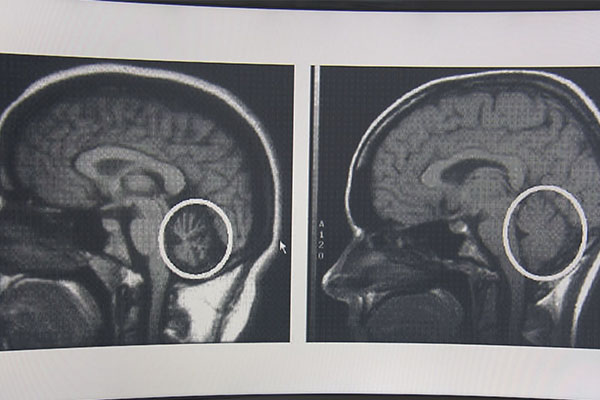根據香港 小腦萎縮症協會 的資料指出,小腦萎縮症的醫學名稱是脊髓小腦運動失調症 (Spinocerebellar Ataxia),簡稱小腦萎縮症(SCA)。患者的小腦、腦幹和脊髓由於基因變異,產生退化性萎縮。致病原因大多數是自體顯性遺傳,少數為基因突變。一般患者在成年期發病,發病年齡大部份從二十至四十歲開始。最近,Vocofy 接觸了一些在香港的小腦萎縮症病人,並開始製作人工智能,將 Vocofy 應用於小腦萎縮症病友 身上。
初期病徵包括:
- 走路時步履不穩,肢體搖晃,有喝醉酒的感覺(眩暈) 。
- 動作反應較不靈活,行走時容易撞到牆壁或門框,提舉重物有困難;端湯、端茶 時,雙手搖晃,湯、茶容易濺出容器。
- 喪失動作的流暢性,無法精確地完成某特定動作,不能進行體操、跑步、打球、爬山等活動;上下樓梯時雙腿不協調,肌肉僵硬,動作笨拙。
- 靜止站立時,軀幹失去平衡,身體會前後搖晃。
中期病徵包括:
- 四肢,肌肉不協調感加重,難以握筆書寫,運動失調現象明顯。
- 舌頭打結,說話時發音含糊不清,無法控制音調。
- 眼球轉動不平順,無法快速,準確地轉移目標;影像容易產生「重疊」。
- 有時感到吞嚥困難,吃東西或喝水時,容易被嗆到。
- 有些患者白天昏昏沈沈,感到倦怠,晚上清醒,甚至無法入睡;有些睡眠時有抽筋現象。
直至晚期,則會出現說話極不清楚,甚至無法言語,寫字無法辨認,吞嚥困難。肢體乏力,無法站立,甚至無法坐起,需靠輪椅代步;或臥病在床,生活無法自理。
現時,Vocofy 正着手為小腦萎縮症病友留聲,訓練 Vocofy 人工智能模型。不少病友跟 Vocofy 團隊表示,溝通上的障礙讓他們感到泄氣。對方聽不明,他們越心急把句子說出,然而,越心急越難控制說話,變得更咬字不清。因此,Vocofy 正利用自家研發的 Text-to-Speech 技術,讓 Vocofy 應用於小腦萎縮症病友 身上,減少生活上的不便。

According to the Hong Kong Cerebellar Atrophy Association, the medical name of cerebellar atrophy is spinocerebellar ataxia (Spinocerebellar Ataxia), referred to as cerebellar atrophy (SCA). The patient’s cerebellum, brainstem, and spinal cord are degeneratively atrophied due to genetic mutations. Most of the pathogenic causes are autodominant inheritance, and a few are gene mutations. Generally, patients develop the disease in adulthood, and the age of onset is mostly from 20 to 40 years old. Recently, Vocofy contacted some patients with cerebellar atrophy in Hong Kong, and started to produce artificial intelligence, and applied Vocofy to patients with cerebellar atrophy.
Early symptoms include:
Unsteady gait, shaky limbs, feeling drunk (vertigo) when walking.
The movement response is not flexible, and it is easy to bump into the wall or door frame when walking, and it is difficult to lift heavy objects; when serving soup and tea, the hands are shaken, and the soup and tea are easy to splash out of the container.
Loss of fluency of movement, inability to accurately complete a specific movement, inability to perform gymnastics, running, playing ball, climbing and other activities; uncoordinated legs when going up and down stairs, muscle stiffness, and clumsy movements.
When standing still, the trunk loses balance and the body rocks back and forth.
Intermediate symptoms include:
The extremities and muscle incoordination are aggravated, it is difficult to hold a pen to write, and the movement disorder is obvious.
Tongue tied, speech slurred and unable to control pitch.
The eyeballs do not move smoothly and cannot quickly and accurately shift the target; images are prone to “overlapping”.
Sometimes it is difficult to swallow, and it is easy to choke when eating or drinking.
Some patients feel drowsy during the day, feel tired, wake up at night, and can’t even fall asleep; some have cramps during sleep.
Until the late stage, there will be very unclear speech, or even inability to speak, unrecognizable writing, and difficulty swallowing. Limb weakness, unable to stand up, or even sit up, need to rely on a wheelchair; or bedridden, unable to take care of themselves.
Currently, Vocofy is starting to record voices for patients with cerebellar atrophy and train Vocofy artificial intelligence models. Many patients told the Vocofy team that the communication barrier made them feel discouraged. The other party can’t hear clearly, the more impatient they are to speak out the sentence, however, the more impatient they are, the more difficult it is to control their speech, and they become more inarticulate. Therefore, Vocofy is using its own Text-to-Speech technology to let them use it, reducing the inconvenience in life.
